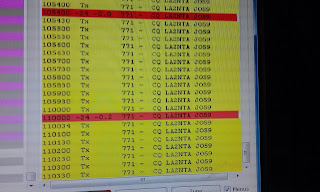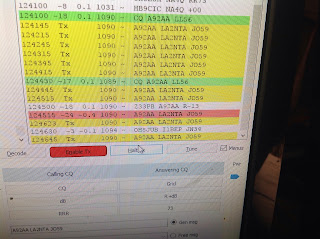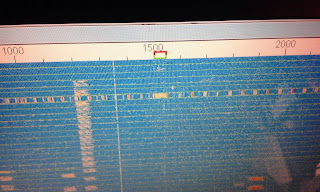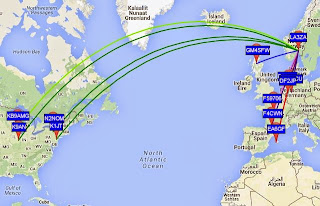Posts Tagged ‘Digital mode’
 Olivia Digital Mode (1000 Hz) on Twenty Meters – A Simple Video
Olivia Digital Mode (1000 Hz) on Twenty Meters – A Simple Video
The Olivia digital mode on HF radio is a mode capable of two-way chat (QSO) communication (keyboard to keyboard, like RTTY) over long-distance shortwave (HF) ionospheric propagation paths, especially over polar regions.
If you are interested in more than a logbook QSO (such as is typical with FT8 and other propagation-checking modes) but want to chat with other hams around the world using digital modes, consider Olivia as one option.
This video captures a few moments of two-way conversation on the Twenty-Meter band, up in the sub-band where 1000-Hz digital modes are commonplace. More narrow-bandwidth settings are used in a lower subband in the digital slice of Twenty Meters. More details about the mode are in the files section of this website: http://OliviaDigitalMode.org.
In 2005, SP9VRC, Pawel Jalocha, released to the world a mode that he developed starting in 2003 to overcome difficult radio signal propagation conditions on the shortwave (high-frequency, or HF) bands. By difficult, we are talking significant phase distortions and low signal-to-noise ratios (SNR) plus multipath propagation effects. The Olivia-modulated radio signals are decoded even when it is ten to fourteen dB below the noise floor. That means that Olivia is decoded when the amplitude of the noise is slightly over three times that of the digital signal!
Olivia decodes well under other conditions that are a complex mix of atmospheric noise, signal fading (QSB), interference (QRM), polar flutter caused by a radio signal traversing a polar path. Olivia is even capable when the signal is affected by auroral conditions (including the Sporadic-E Auroral Mode, where signals are refracted off of the highly-energized E-region in which the Aurora is active).
Currently, the only other digital modes that match or exceed Olivia in their sensitivity are some of the modes designed by Joe Taylor as implemented in the WSJT programs, including FT8, JT65A, and JT65-HF–each of which are certainly limited in usage and definitely not able to provide true conversation capabilities. Olivia is useful for emergency communications, unlike JT65A or the popular FT8. One other mode is better than Olivia for keyboard-to-keyboard comms under difficult conditions: MT63. Yet, Olivia is a good compromise that delivers a lot. One reason for this is that there are configurations that use much less bandwidth than 1000 Hz. 16 tones in 250 Hz is our common calling-frequency configuration, which we use lower down in the Twenty-Meter band, with a center frequency of 14.0729 MHz.
Q: What’s a ‘CENTER’ Frequency? Is That Where I Set My Radio’s Dial?
For those new to waterfalls: the CENTER frequency is the CENTER of the cursor shown by common software. The cursor is what you use to set the transceiver’s frequency on the waterfall. If your software’s waterfall shows the frequency, then you simply place the cursor so that its center is right on the center frequency listed, above. If your software is set to show OFFSET, then you might, for example, set your radio’s dial frequency to 14.0714, and place the center of your waterfall cursor to 1500 (1500 Hz). That would translate to the 14.0729 CENTER frequency.
The standard Olivia formats (shown as the number of tones/bandwidth in Hz) are 8/250, 8/500, 16/500, 8/1000, 16/1000, and 32/1000. Some even use 16/2000 for series emergency communication. The most commonly-used formats are 16/500, 8/500, and 8/250. However, the 32/1000 and 16/1000 configurations are popular in some areas of the world (Europe) and on certain bands.
These different choices in bandwidth and tone settings can cause some confusion and problems–so many formats and so many other digital modes can make it difficult to figure out which mode you are seeing and hearing. After getting used to the sound and look of Olivia in the waterfall, though, it becomes easier to identify the format when you encounter it. To aid in your detection of what mode is being used, there is a feature of many digital-mode software implementation suites: the RSID. The next video, below, is a demonstration on how to set the Reed-Solomon Identification (RSID) feature in Ham Radio Deluxe’s Digital Master 780 module (HRD DM780).
I encourage ALL operators, using any digital mode such as Olivia, to TURN ON the RSID feature as shown in this example. In Fldigi, the RSID is the TXID and RXID; make sure to check (turn on) each, the TXID and RXID.
Please, make sure you are using the RSID (Reed Solomon Identification – RSID or TXID, RXID) option in your software. RSID transmits a short burst at the start of your transmission which identifies the mode you are using. When it does that, those amateur radio operators also using RSID while listening will be alerted by their software that you are transmitting in the specific mode (Olivia, hopefully), the settings (like 8/250), and where on the waterfall your transmission is located. This might be a popup window and/or text on the receive text panel. When the operator clicks on that, the software moves the waterfall cursor right on top of the signal and changes the mode in the software. This will help you make more contacts!
RSID Setting:
+ NOTE: The MixW software doesn’t have RSID features. Request it!
Voluntary Olivia Channelization
Since Olivia signals can be decoded even when received signals are extremely weak, (signal to noise ratio of -14db), signals strong enough to be decoded are sometimes below the noise floor and therefore impossible to search for manually. As a result, amateur radio operators have voluntarily decided upon channelization for this mode. This channelization allows even imperceptibly weak signals to be properly tuned for reception and decoding. By common convention amateur stations initiate contacts utilizing 8/250, 16/500, or 32/1000 configuration of the Olivia mode. After negotiating the initial exchange, sometimes one of the operators will suggest switching to other configurations to continue the conversation at more reliable settings, or faster when conditions allow. The following table lists the common center frequencies used in the amateur radio bands.
Olivia (CENTER) Frequencies (kHz) for Calling, Initiating QSOs
It is often best to get on standard calling frequencies with this mode because you can miss a lot of weak signals if you don’t. However, with Olivia activity on the rise AND all the other modes vying for space, a good deal of the time you can operate wherever you can find a clear spot–as close as you can to a standard calling frequency.
Note: some websites publish frequencies in this band, that are right on top of weak-signal JT65, JT9, and FT8 segments. DO NOT QRM weak-signal QSOs!
We (active Olivia community members) suggest 8/250 as the starting settings when calling CQ on the USB frequencies designated as ‘Calling Frequencies.’ A Calling Frequency is a center frequency on which you initially call, ‘CQ CQ CQ. . .’ and then, with the agreement of the answering operator, move to a new nearby frequency, changing the number of tones and bandwidth at your discretion. Even though 8/250 is slow, the CQ call is short. But, it is narrow, to allow room for other QSOs nearby. It is also one of the best possible Olivia configurations for weak-signal decoding.
 Short Demonstration of Using Ham Radio Deluxe with WSJT-X and FT8 Digital Mode
Short Demonstration of Using Ham Radio Deluxe with WSJT-X and FT8 Digital Mode
Ham Radio Deluxe can log your WSJT-X FT8, JT65A, and JT9 QSOs, via the JT-Alert software. This is a demonstration of my use of HRD and Logbook, during an FT8 QSO,today.
As some of you know, I have had some differences of opinion regarding the selection of frequencies chosen by the FT8 creators and advocates. Regardless, I do still use the mode. Here is proof:
Go ahead and share, if you would. And, please subscribe to my YouTube channel, as I will be creating many how-to videos in the near future.
Thanks and 73 … de NW7US
 FT8 anomaly or long delayed echo?
FT8 anomaly or long delayed echo?
My friend Alf, LA2NTA, has sent med these screenshots from when he has been operating FT8. The first image is when operating 10 meters and took place early in November.
 |
| Two of LA2NTA CQs being received by himself on 10 meter (in red) |
It shows how his own CQ comes back to him at 10.54.00 and at 11.00.00 and is decoded in his own receiver.
The second example is from 20 meters and took place just a few days ago.
 |
| LA2NTA CQ being received by himself on 20 meter (in red) |
 |
| FT8 band on 10 meters showing some form of noise all over the band |
 Calling Olivia-mode Operators (from All Regions)
Calling Olivia-mode Operators (from All Regions)
Calling all Olivia-mode operators with experience using the Olivia digital mode in all areas of the world:
Please join our Facebook group at the following link. We are discussing important operational changes!
If you are on Facebook, and interested in the Olivia HF radioteletype chat mode, please join the community group at the following link: https://www.facebook.com/groups/olivia.hf/
If you want to join our discussion by way of the Olivia group on Groups.io, please feel free to spread the news, and also to subscribe to that group email reflector. We’ll start discussions, soon. Here’s the link: https://groups.io/g/Olivia
OLIVIA (Also, Olivia MFSK) is an amateur digital radioteletype mode designed by Pawel Jalocha, SP9VRC, starting in 2003, and in use by 2005. The Olivia-mode goal was to be effective even in poor propagation conditions on the high frequencies (shortwave).
OLIVIA can decode well under noise, propagational fading (QSB), interference (QRM), flutter caused by polar path propagation and even auroral conditions and sporadic-E. Olivia uses a 7-bit ASCII alphabet. There were a handful of amateur digital modes that were derived from Olivia, including RTTYM and PAX.
Outside of amateur radio two-way communication, this mode is utilized during the tests run by the VoA every weekend. See the VoA RadioGram website, VoARadiogram.net, for the schedule.

The Olivia QSO between K4SOL and NW7US using 16/500 mode settings on shortwave, 2017-AUG-06 @1410UTC
The first on-the-air tests were performed by two radio amateurs, Fred OH/DK4ZC and Les VK2DSG on the Europe-Australia path in the 20-meter amateur band. The tests proved that the protocol works well and can allow regular intercontinental radio contacts with as little as one watt RF power. Since 2005 Olivia has become a standard for digital data transfer under white noise, fading and multipath, flutter (polar path) and auroral conditions.
Voluntary channelization
Since Olivia signals can be decoded even when received signals are extremely weak, (signal to noise ratio of -14 dB), signals strong enough to be decoded are sometimes below the noise floor and therefore impossible to search for manually.
As a result, amateur radio operators have voluntarily decided upon channelization for this mode. This channelization allows even imperceptibly weak signals to be properly tuned for reception and decoding. By common convention amateur stations initiate contacts utilizing either the 16/500 or 32/1000 modes and then switch to other modes to continue the conversation. The following table lists the common center frequencies used in the amateur radio bands.
The traditional channels are now under heavy use by newer modes. Thus, this Olivia group is working on refiguring the strategy for continued use and channelization. Please join us for discussion.
https://www.facebook.com/groups/olivia.hf/
Thank you,
Tomas / NW7US
 ETH067 – I Think I Have The PSK31 Bug Thanks to Ian Kahn, KM4IK
ETH067 – I Think I Have The PSK31 Bug Thanks to Ian Kahn, KM4IK
Over the past 67 episodes of my podcast, there has been a couple episodes that have really peaked my interest and kind of lit a fire under me to do whatever that topic is myself. Things like APRS back in episode 6, and Broadband Hamnet in episode 29. However, neither of those got me back onto HF. My HF rig has basically gone unused for close to seven years or so and has been in a box for the last three years!!
I honestly have never been big on voice communications on HF. All of the times that I have operated on HF has either been at home calling CQ or looking for someone else calling it or during things like Field Day. At home I rarely got anyone to answer my CQ call; I think I was getting out. During field day it was, basically the exchange and on to the next contact. Neither of these things were very fun to me.
Digital modes, especially thing like PSK31, seem to be right up my alley! So I decided to look for someone that knew something about it, that I could learn from. I finally found Ian Kahn, KM4IK and he agreed to come onto my show and talk to me about it. We had a great conversation and I learned a lot. If you are interested in learning about PSK31, head over to the show notes of the episode, you can listen right on the page, or you can search for Everything Ham Radio on the major podcast directories.
 The ultimate WSPR spot
The ultimate WSPR spot
A spot reported by K1JT must be the ultimate goal for the WSPR mode. K1JT, Joseph Taylor, is the Nobel laureate who first developed this mode and other related two-way modes like JT65 and JT9.
My 0.1 W 21 MHz WSPR transmitter regularly makes it over the Atlantic, but never before to K1JT. The SWR was something like 7:1, but apparently that works fine, both for the transmitter and for radiation.
The antenna is a 13 m doublet oriented with the broadside facing East-West (the EU spots in the figure are from my Ultimate 3 on 21 MHz with another antenna and at another location). I feed the doublet with 450 ohm ladder line to a 4:1 Elecraft balun which is connected to the Ultimate 2 transmitter.
 The ultimate WSPR spot
The ultimate WSPR spot
A spot reported by K1JT must be the ultimate goal for the WSPR mode. K1JT, Joseph Taylor, is the Nobel laureate who first developed this mode and other related two-way modes like JT65 and JT9.
My 0.1 W 21 MHz WSPR transmitter regularly makes it over the Atlantic, but never before to K1JT. The SWR was something like 7:1, but apparently that works fine, both for the transmitter and for radiation.
The antenna is a 13 m doublet oriented with the broadside facing East-West. I feed it with 450 ohm ladder line to a 4:1 Elecraft balun which is connected to the Ultimate 2 transmitter.














